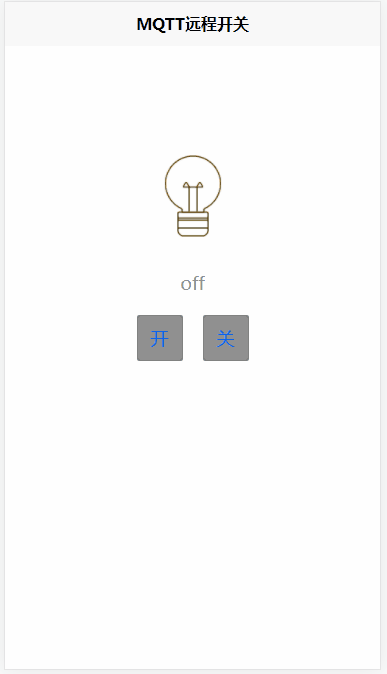本文实现的目标是用手机远程控制 esp8266 板载 LED 熄灭。
效果图:

1. 自有服务器搭建MQTT服务端,用的是nodejs平台
server.js
const mosca = require("mosca");
//https密钥路径
// const SECURE_KEY=dirname+'/key.pem"
// const SECURE_CERT = dirname+"/cert.pem"
//设置参数
const mqttSetting = {
interfaces:[
{
type: "mqtt", port: 1883 },
{
type: "http", port: 3000, bundle: true }
//{ type: "mqtts", port: 8883, bundle: true, credentials: { keyPath: SECURE_KEY, certPath: SECURE_CERT } },
//{ type: "https", port: 1884, bundle: true, credentials: { keyPath: SECURE_KEY, certPath: SECURE_CERT } }
]
}
//实例化
const MqttServer = new mosca.Server(mqttSetting)
//开启服务
MqttServer.on("ready", function() {
console.log("mqtt is running...");
});
//监听客户端连接
MqttServer.on("clientConnected", function(client) {
console.log("client connected", client.id);
});
//监听MQTT主题消息,当客户端发布主题消息时执行
MqttServer.on("published", function(packet, client) {
var topic = packet.topic;
switch (topic) {
case "test_topic":
console.log('message', packet.payload.toString());
//MQTT可以转发主题消息至其他主题
//MqttServer.publish({ topic: 'other', payload: 'sssss' });
break;
case "other":
console.log("message_other", packet.payload.toString());
break;
}
});
运行服务:
node server.js
第一次运行会报错,解决方法点这里
2. Arduino 编写程序上传到 ESP8266-NodeMCU
NodeMCU模块第一次通电会打开wifi等待连接配网,网络配置好之后每次通电都会自动连接到 mqtt 服务器订阅、发布消息。
代码来源 太极创客
#include <ESP8266WiFi.h>
#include <DNSServer.h>
#include <ESP8266WebServer.h>
#include <WiFiManager.h>
#include <PubSubClient.h>
#include <Ticker.h>
const char* mqttServer = "48.128.128.88"; // mqtt服务器地址
int count; // Ticker计数用的变量
Ticker ticker;
WiFiClient wifiClient;
PubSubClient mqttClient(wifiClient);
//计数
void tickerCount(){
count++;
}
// 连接MQTT服务器
void connectMQTTServer(){
// 根据ESP8266的MAC地址生成客户端ID(避免与其它ESP8266的客户端ID重名,否则会出现订阅异常)
String clientId = "esp8266-" + WiFi.macAddress();
if (mqttClient.connect(clientId.c_str())) {
Serial.println("MQTT Server Connected.");
Serial.println("Server Address: ");
Serial.println(mqttServer);
Serial.println("ClientId:");
Serial.println(clientId);
subscribeTopic(); // ****订阅指定主题****
} else {
Serial.print("MQTT Server Connect Failed. Client State:");
Serial.println(mqttClient.state());
delay(3000);
}
}
// 发布信息
void pubMQTTmsg(){
// 建立发布主题
String topicString = "test/esp8266/pub" ;
char publishTopic[topicString.length() + 1];
strcpy(publishTopic, topicString.c_str());
// 建立发布信息,当前D3引脚状态
// String messageString;
// if(digitalRead(D3)){
// messageString = "on";
// } else {
// messageString = "off";
// }
// 建立发布信息,板块自带的LED状态
String messageString;
if(digitalRead(LED_BUILTIN)){
messageString = "off";
} else {
messageString = "on";
}
char publishMsg[messageString.length() + 1];
strcpy(publishMsg, messageString.c_str());
// 实现ESP8266向主题发布信息,并在串口监视器显示出来
if(mqttClient.publish(publishTopic, publishMsg)){
Serial.println("Publish Topic:");Serial.println(publishTopic);
Serial.println("Publish message:");Serial.println(publishMsg);
} else {
Serial.println("Message Publish Failed.");
}
}
// 订阅指定主题
void subscribeTopic(){
// 建立订阅主题名称为 test/esp8266/sub
String topicString = "test/esp8266/sub" ;
char subTopic[topicString.length() + 1];
strcpy(subTopic, topicString.c_str());
// 通过串口监视器输出是否成功订阅主题以及订阅的主题名称
if(mqttClient.subscribe(subTopic)){
Serial.println("Subscribe Topic:");
Serial.println(subTopic);
} else {
Serial.print("Subscribe Fail...");
}
}
// 收到信息后的回调函数
void receiveCallback(char* topic, byte* payload, unsigned int length) {
Serial.print("Message Received [");
Serial.print(topic);
Serial.print("] ");
for (int i = 0; i < length; i++) {
Serial.print((char)payload[i]);
}
Serial.println("");
Serial.print("Message Length(Bytes) ");
Serial.println(length);
if ((char)payload[0] == '1') {
// 如果收到的信息以“1”为开始
digitalWrite(LED_BUILTIN, LOW); // 则点亮LED。
} else {
digitalWrite(LED_BUILTIN, HIGH); // 否则熄灭LED。
}
}
//程序入口
void setup() {
//开启串口通讯
Serial.begin(9600);
// 建立WiFiManager对象
WiFiManager wifiManager;
//设置输出信号的引脚,此处是板载的LED
pinMode(LED_BUILTIN, OUTPUT);
// 如果您希望该WiFi添加密码,可以使用以下语句,第二个参数是密码
// wifiManager.autoConnect("AutoConnectAP", "12345678");
// 自动连接WiFi。以下语句的参数是连接ESP8266时的WiFi名称
wifiManager.autoConnect("AutoConnectAP");
// WiFi连接成功后将通过串口监视器输出连接成功信息
Serial.println("");
Serial.print("ESP8266 Connected to ");
Serial.println(WiFi.SSID()); // WiFi名称
Serial.print("IP address:\t");
Serial.println(WiFi.localIP()); // IP
// 设置MQTT服务器和端口号
mqttClient.setServer(mqttServer, 1883);
// 收到信息后的回调函数
mqttClient.setCallback(receiveCallback);
// 连接MQTT服务器
connectMQTTServer();
// Ticker定时对象
ticker.attach(1, tickerCount);
}
//循环执行
void loop() {
if (mqttClient.connected()) {
// 如果开发板成功连接服务器
// 每隔5秒钟发布一次信息
if (count >= 5){
pubMQTTmsg();
count = 0;
}
// 保持心跳
mqttClient.loop();
} else {
// 如果开发板未能成功连接服务器
connectMQTTServer(); // 则尝试连接服务器
}
}
3. uniapp 编写移动端操作开关灯
<template>
<view class="content">
<!-- <image class="logo" src="/static/logo.png" ></image> -->
<image class="logo" :src="title=='on' ? imgurlon : imgurloff"></image>
<view class="text-area">
<view class="title">{
{
title}}</view>
</view>
<view class="btn">
<button type="default" @click="btnon()">开</button>
<button type="default" @click="btnoff()">关</button>
</view>
</view>
</template>
<script>
var mqtt = require('../../mqtt.min.js') //引入mqtt库
export default {
data() {
return {
title: 'Hello',
imgurloff:'/static/off.png',
imgurlon:'/static/on.png',
//app端和小程序端必须用【 wx:// 或者 wxs:// 】
urls: 'wx://48.128.128.88:3000/mqtt',
client: null,
//MQTT连接的配置
options: {
clientId: '',
clean: false,
password: 'admin',
username: 'public',
keepalive: 0, //心跳时间
}
}
},
onLoad() {
// 多设备登录的时候 clientId 不能重复,否则消息订阅会有冲突,此处以时间戳作为clientId
this.options.clientId = 'App' + Math.round(new Date() / 1000)
//延迟一秒再调用方法,作用是等待赋值给clientId
setTimeout( ()=> {
this.mqttconnect()
},1000)
},
methods: {
mqttconnect() {
this.client = mqtt.connect(this.urls,this.options)
//连接服务器
this.client.on('connect', () => {
// 订阅默认主题
this.client.subscribe('test/esp8266/pub', (err) => {
console.log(err || '订阅默认主题成功')
})
//发布消息
this.client.publish('test/esp8266/pub', 'testmsg', (err) => {
console.log(err || '发送信息成功')
})
})
//收取消息
this.client.on('message', (topic, message) => {
let msg = message.toString();
this.title = msg
console.log('收到来自'+ topic + '的消息:' + message.toString());
})
},
btnon() {
//发布开灯指令
this.client.publish('test/esp8266/sub', '1', (err) => {
console.log(err || '发送信息成功')
})
this.title = 'on'
},
btnoff() {
//发布关灯指令
this.client.publish('test/esp8266/sub', '0', (err) => {
console.log(err || '发送信息成功')
})
this.title = 'off'
}
}
}
</script>
<style>
.content {
display: flex;
flex-direction: column;
align-items: center;
justify-content: center;
}
.logo {
height: 200rpx;
width: 200rpx;
margin-top: 200rpx;
margin-left: auto;
margin-right: auto;
margin-bottom: 50rpx;
}
.text-area {
display: flex;
justify-content: center;
}
.title {
font-size: 36rpx;
color: #8f8f94;
}
.btn{
display: flex;
flex-direction: row;
margin: 20rpx;
}
button{
margin: 20rpx;
border-radius: 5rpx;
color: #0055ff;
background-color: #909090;
}
</style>